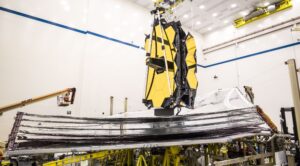JWST schedule margin shrinks

WASHINGTON — While NASA achieves milestone assembling and testing the James Webb Space Telescope, a key manager said the mission only has a few months of schedule reserve left ahead of a March 2021 launch.
In a presentation to NASA’s Astrophysics Advisory Committee Oct. 29, Greg Robinson, program director for JWST at NASA Headquarters, said the agency and prime contractor Northrop Grumman are making progress with the integration and testing of the telescope at a Northrop facility in Southern California.
“In the past six months, we’ve seen a lot of really good progress bringing the observatory together,” he said. That included the integration of the spacecraft’s optics and instruments section with the spacecraft bus and sunshield in August. On Oct. 21, NASA announced the combined spacecraft successfully completed a deployment test of its five-layer sunshield.
Robinson said that the spacecraft has not suffered any major technical issues during recent testing. Instead, the program has been working through smaller issues. “The good news is that the team is doing all of the right work, and they’re doing it in the right way,” he said. “There are small new discoveries that cost us a day, two or three days, a week.”
One such problem is with an electronics unit called a command telemetry processor that malfunctioned during environmental testing. Robinson said engineers had problems duplicating the problem to determine the root cause and plan to replace the unit, along with a traveling wave tube amplifier used in the spacecraft’s communications system that also failed during testing.
NASA has also been working with launch provider Arianespace about concerns that residual pressure within the payload fairing at the time of fairing separation could “over-stress” the sunshield membranes. Tests on recent Ariane 5 launches confirmed that there was a higher residual pressure than the sunshield was designed for. Vents in the fairing are being redesigned to address this, Robinson said, and will be tested on Ariane 5 launches in early 2020.
However, those smaller problems, along with bigger issues like fastener problems with the sunshield found during environmental testing last year, have eroded the margin built into the revised schedule for the mission. Robinson said that revised schedule in June 2018 provided about nine months of schedule reserve, but now there was “just over two months of schedule margin” remaining.
Most missions expect to use up schedule reserve as they progress towards launch. However, earlier this year Tom Young, who chaired the Independent Review Board chartered by NASA last year to review cost and schedule problems with JWST, warned that the mission appeared to be using up schedule reserve at a higher-than-expected rate.
Program officials later said that high rate of scheduled reserve use was to address problems they felt were behind them. Robinson said that the recent deployment of the sunshield “was almost error-free” with no new problems.
He said he expected to continue to see “routine issues” during integration and testing that slow down work on the mission slightly. “Those will continue, hopefully fewer and shorter,” he said. “But right now I don’t expect anything major.”
A major problem, though, could wipe out that schedule reserve. “If we encounter a big problem, something really significant, that’s a semi-bad day, schedule-wise,” he said.
from SpaceNews.com https://ift.tt/2Pumt9W
Comments
Post a Comment